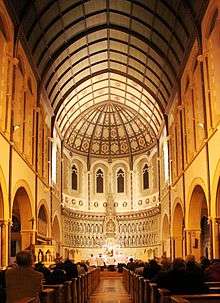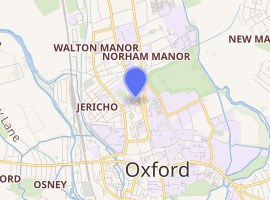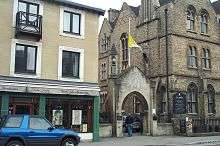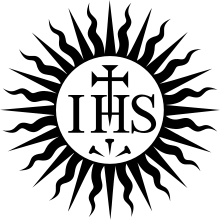Oxford Oratory
The Oxford Oratory Church of St Aloysius Gonzaga (or Oxford Oratory for short) is the Catholic parish church for the centre of Oxford, England. It is located at 25 Woodstock Road, next to Somerville College. The church is served by the Congregation of the Oratory.
| Oxford Oratory | |
|---|---|
| Oxford Oratory Church of St Aloysius Gonzaga | |
 Oxford Oratory | |

| |
| Location | Oxford |
| Country | England |
| Denomination | Roman Catholic |
| Religious order | Oratorians (formerly Jesuits) |
| Architecture | |
| Heritage designation | Grade II listed |
| Architect(s) | Joseph Hansom |
| Completed | 1875 |
| Administration | |
| Archdiocese | Roman Catholic Archdiocese of Birmingham |
| Clergy | |
| Provost | Very Rev Fr Nicholas Edmonds-Smith |
History

St Aloysius' was founded as the Jesuit (Society of Jesus) parish of central Oxford. Completed in 1875, the building of St Aloysius' was an important step in the ongoing refoundation of a Roman Catholic presence in Oxford. The parish was served by notable members of the society for many years, including Gerard Manley Hopkins (December 1878 – September 1879). The church also housed a notable collection of relics bequeathed by Hartwell de la Garde Grissell, many of which were destroyed in the 1970s.
In the 1980s, the Jesuits left the church and the parish was taken over by the Archdiocese of Birmingham. In 1990, the Archbishop of Birmingham invited members of the Birmingham Oratory to take over the running of the parish and found a new Oratorian community in Oxford. Two priests from Birmingham arrived in September 1990 and, in 1993, the Oxford Oratory was established as an independent Congregation. Fr Robert Byrne then served as provost from 1993 to 2011.[1] From 2011-2019, Fr Daniel Seward served as provost.[2] The incumbent is the Very Rev. Fr Nicholas Edmonds-Smith.
Liturgy
It is part of the tradition of the Oratory in England to ensure that the liturgy is celebrated in a dignified and worthy manner. In the Oxford Oratory most Masses are celebrated in English, but on Sundays and Holydays a non-Tridentine Solemn Mass is sung in Latin. Latin is also used in the Tridentine Low Mass also celebrated on Sundays and Holydays, while the Parish Mass is sung in English.[3]
Organ
The organ was enlarged between 1998 and 2004 by Matthew Copley. A specification of the organ can be found on the National Pipe Organ Register.[4]
Building
The church was designed by Joseph Hansom in a Gothic Revival style.[5] Much of the original interior decoration was painted over in the 1970s, and the altar moved forward. The building is being gradually restored as part of the "Oxford Oratory - Reaffirmation & Renewal" campaign.
The church consists of a single nave and five side chapels. To the left of the sanctuary is the Sacred Heart chapel, and the Lady Chapel is to the right. There are also chapels dedicated to St Philip Neri (formerly St Joseph's chapel) and Our Lady of Oxford (also known as the relic chapel). There are plans to build a new baptistery and a chapel dedicated to Cardinal Newman after his beatification in September 2010.
Gallery
 Church altar
Church altar Church sanctuary
Church sanctuary View of the altar
View of the altar
References
- "Pope appoints Fr Robert Byrne as new Auxiliary Bishop of Birmingham". Catholic News. Catholic Trust for England and Wales. 15 March 2014. Retrieved 27 January 2017.
- "New Provost Elected". The Oxford Oratory. The Oxford Oratory Trust. 2 February 2011. Retrieved 27 January 2017.
- The Oxford Oratory: Mass Times (retrieved in August 2019)]
- http://www.npor.org.uk/cgi-bin/Rsearch.cgi?Fn=Rsearch&rec_index=K00223
- Harris, Penelope, "The Architectural Achievement of Joseph Aloysius Hansom (1803-82), Designer of the Hansom Cab, Birmingham Town Hall and Churches of the Catholic Revival", The Edwin Mellen Press, 2010, ISBN 0-7734-3851-3
